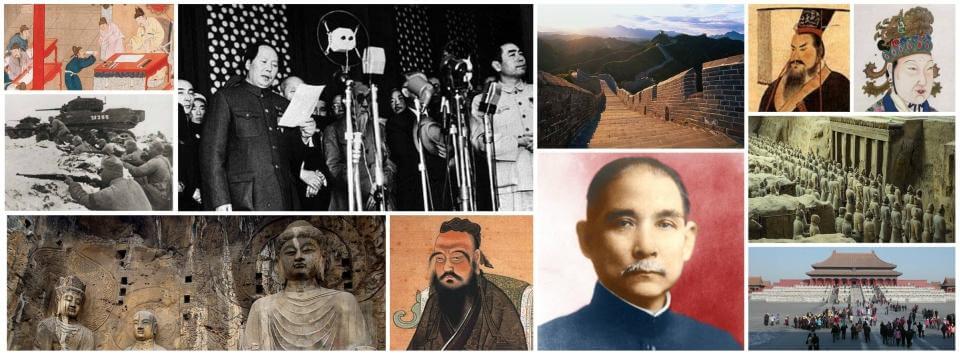
Banpo Museum
The information contained here are subject to change. Chinese History Digest is not responsible or liable if any changes should occur. You can also check the official website of the Banpo Museum for the latest information.
Opening Hours
March - November: 8am - 6pm
December - February: 8am - 5.30pm
Entrance Ticket Prices
March - November: 55 yuan
December - February: 40 yuan
Free for children under 1.2m
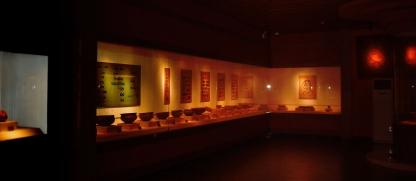 neolithic pottery exhibited at Xi'an's Banpo MuseumThe Banpo Museum is an archaeological museum that is located in the eastern part of Xi'an (Shaanxi province). There, the museum was opened in 1958 right next to the prehistoric Banpo Site. At the time of its opening, the Banpo Museum was the first museum in China that exhibited archaeological artefacts right at the site where they were excavated from.
neolithic pottery exhibited at Xi'an's Banpo MuseumThe Banpo Museum is an archaeological museum that is located in the eastern part of Xi'an (Shaanxi province). There, the museum was opened in 1958 right next to the prehistoric Banpo Site. At the time of its opening, the Banpo Museum was the first museum in China that exhibited archaeological artefacts right at the site where they were excavated from.
The oval-shaped Banpo village whose ruins have been excavated at the Banpo Site is estimated to have been occupied during prehistoric times from around 4,500 BC until about 3,750 BC. It is unclear why the site was suddenly abandoned then. Evidence of ancient flood damage was found at the site but is until now still regarded as inconclusive.
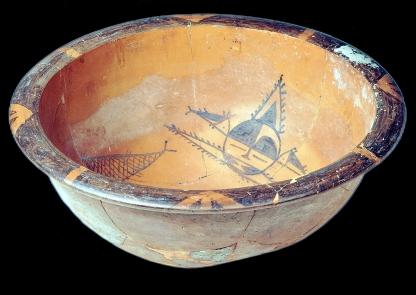 Banpo pottery basin with fish & net decorationThe Banpo people that inhabited this prehistoric village belonged to the Yangshao culture, one of the most important neolithic cultures that lasted for about 2,000 years from around 5,000 BC until about 3,000 BC. Due to the beautifully decorated pottery it produced, the Yangshao culture is also known as the Painted Pottery Culture.
Banpo pottery basin with fish & net decorationThe Banpo people that inhabited this prehistoric village belonged to the Yangshao culture, one of the most important neolithic cultures that lasted for about 2,000 years from around 5,000 BC until about 3,000 BC. Due to the beautifully decorated pottery it produced, the Yangshao culture is also known as the Painted Pottery Culture.
More than 1,000 Yangshao culture sites have so far been discovered in the area around the middle reaches of the Yellow River. The Banpo Site is one of the two most famous and significant of all these sites. The other key site is located in Mianchi County (Henan province). Since it was discovered first, this other key site is known as the Yangshao Site. A modern museum - the Yangshao Culture Museum - was opened right next to the Yangshao Site in 2011. History buffs that want to learn more about this prehistoric culture should consider including this site and museum in their travel itinerary as well.
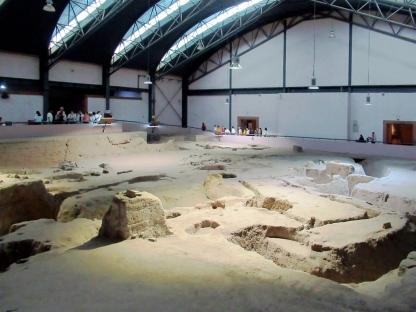 Banpo village excavation at the museum's site hallThe site of the ancient Banpo village was discovered by mere chance in October 1953 when workers of the Banpo work group excavated earth to make space for the foundations of a new factory building. After the remains of the neolithic village were discovered, the workers switched bosses and henceforth worked for the archaeologists. As a way to honour the workers who had discovered it, the archaeological site was eventually named Banpo. The Institute of Archaeology at the Chinese Academy of Social Sciences took over responsibility for the excavations which were the largest that had until then been carried out in the recently-founded People's Republic of China.
Banpo village excavation at the museum's site hallThe site of the ancient Banpo village was discovered by mere chance in October 1953 when workers of the Banpo work group excavated earth to make space for the foundations of a new factory building. After the remains of the neolithic village were discovered, the workers switched bosses and henceforth worked for the archaeologists. As a way to honour the workers who had discovered it, the archaeological site was eventually named Banpo. The Institute of Archaeology at the Chinese Academy of Social Sciences took over responsibility for the excavations which were the largest that had until then been carried out in the recently-founded People's Republic of China.
The entire Banpo Site covers an area of about 20 acres. Five successive large-scale excavations of the site went on from 1954 until 1957 and revealed 250 tombs, 6 large kilns, about 200 underground storage pits and the foundations of about 100 village houses. The clay houses were insulated with wattle and daub and topped by overhanging thatched roofs that created shaded front porches. Most houses were circular with sunken floors up to one meter deep. A few houses were square with rounded corners and there was also one large rectangular building that the Banpo people probably used for storage and gatherings.
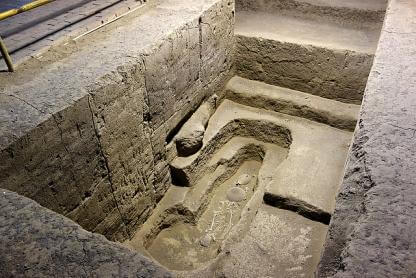 excavated tomb at the Banpo SiteThe village cemetery was located in the northern part of Banpo village and the kilns where decorated pottery was produced were located just east of it. There were also two farmyards for livestock on the village grounds. A 6-meter-wide and up to 6-meter-deep moat surrounded Banpo village as a protective measure against dangerous wild animals and snakes. It also served to drain water after heavy rains.
excavated tomb at the Banpo SiteThe village cemetery was located in the northern part of Banpo village and the kilns where decorated pottery was produced were located just east of it. There were also two farmyards for livestock on the village grounds. A 6-meter-wide and up to 6-meter-deep moat surrounded Banpo village as a protective measure against dangerous wild animals and snakes. It also served to drain water after heavy rains.
We now know that the Banpo people maintained a matrilineal society where one's ancestry was traced through the mother's line. The fact that the women were in charge has been shown by the excavation of the tombs at the Banpo village cemetery. Without a single exception, tombs with female occupants contained substantially more grave goods than the tombs of males. However, the higher social status of females came with the responsibility of having to take care of most tasks in the village (incl. making pottery). Mothers raised their children largely without the involvement of the men that had fathered them. Men were mostly engaged in fishing and hunting. In the evenings, they would visit the huts where the women lived and then leave again the next morning. The Mosuo people still practice this type of marital relationship in China today.
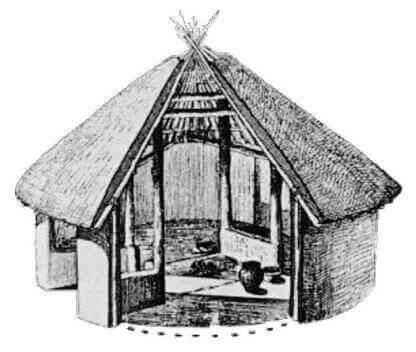 drawing of a typical Banpo village hutThe tools that the Banpo people used for their tasks were primarily made of wood, stone and bone. You can see a large share of the roughly 10,000 prehistoric relics that were uncovered at the Banpo Site displayed at the Banpo Museum. The museum consists of two exhibition halls and a site hall that all together provide about 4,500 square meters of exhibition space. In the two thematic areas of the first exhibition hall, you will see production tools and domestic tools that the Banpo people used back then (axes, chisels, sickles, stone and pottery knives) as well as artwork and adornments. The two sections of the second exhibition hall are used for various temporary exhibitions that deal with topics such as ethnology, folklore and prehistoric art.
drawing of a typical Banpo village hutThe tools that the Banpo people used for their tasks were primarily made of wood, stone and bone. You can see a large share of the roughly 10,000 prehistoric relics that were uncovered at the Banpo Site displayed at the Banpo Museum. The museum consists of two exhibition halls and a site hall that all together provide about 4,500 square meters of exhibition space. In the two thematic areas of the first exhibition hall, you will see production tools and domestic tools that the Banpo people used back then (axes, chisels, sickles, stone and pottery knives) as well as artwork and adornments. The two sections of the second exhibition hall are used for various temporary exhibitions that deal with topics such as ethnology, folklore and prehistoric art.
The 3,000-square-meter site hall of the Banpo Museum provides visitors with a good overview of the excavated sections of the Banpo Site. You will be walking on elevated walkways that lead around each of the three excavation sections. There is a residential section, a pottery-making section and a burial section. The residential section is the largest of the three sections and the main part of the prehistoric Banpo village. This is where you can see the excavated foundations of the primitive huts that the Banpo people once lived in.
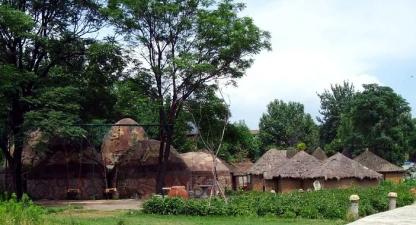 Banpo Primitive Cultural Village near the excavated Banpo SiteIn the pottery-making section, you will see the foundations of the 6 ancient kilns that were used to create pottery. The Banpo people shaped their pottery by hand. Various patterns were used to decorate every piece of pottery such as geometric shapes, floral designs and images of people and animals. Distinct scratch marks that have been identified on certain pottery shards suggest the possibility that an early form of writing may have already existed at that time. That conclusion is still regarded as unproven though.
Banpo Primitive Cultural Village near the excavated Banpo SiteIn the pottery-making section, you will see the foundations of the 6 ancient kilns that were used to create pottery. The Banpo people shaped their pottery by hand. Various patterns were used to decorate every piece of pottery such as geometric shapes, floral designs and images of people and animals. Distinct scratch marks that have been identified on certain pottery shards suggest the possibility that an early form of writing may have already existed at that time. That conclusion is still regarded as unproven though.
At the burial section, you can see the tombs where the people that lived in Banpo village were buried. Altogether, a total of 250 tombs were uncovered at this cemetery site. Children were buried in large clay jugs. The bodies of adult females and males on the other hand were accompanied by several grave goods. The number of grave goods indicated the social status of the buried person.
After having visited the site hall of the Banpo Museum, visitors will find two more attractions just behind it. The first of these is the Banpo Primitive Cultural Village, a collection of huts that illustrate the conditions under which the Banpo people once lived. Nearby, you will find a peony garden that will make your heart rejoice if you're coming between late spring and early summer when it is in bloom.
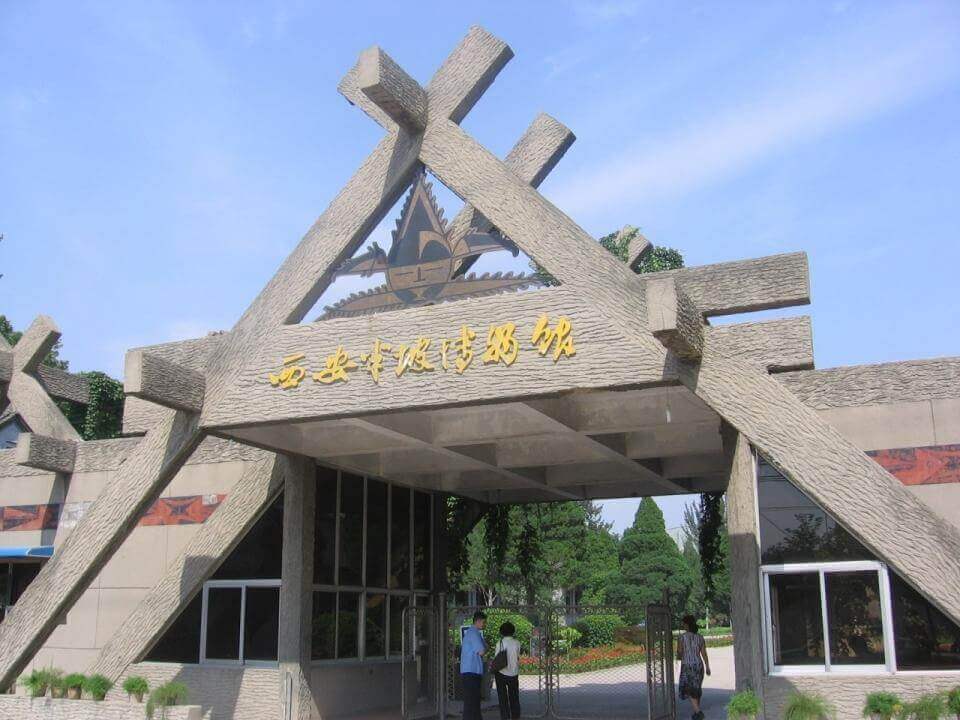 Entrance of the Banpo Museum in Xi'an
Entrance of the Banpo Museum in Xi'an
How to get to the Banpo Museum in Xi'an?
| Address: | Banpo Museum, 155 Banpo Road, Baqiao district, Xi'an, Shaanxi province, China |
| Tel.Nr.: | +86 29 8351 2807 (Ticket Office) |
| Airport: | Xi'an Xianyang International Airport (XIY) |
| Train Station: | Xi'an Railway Station, Xi'an North Railway Station, Xi'an South Railway Station |
| Metro: | Banpo Station - Subway Line 1 Take Exit A and walk westward for ~ 5 min, then turn south to walk along Banpo Road for ~ 2 min |
| Bus: | Banpo Bowuguan Station (bus lines: 105, 269, 406, 416); Banpo Hub Station (bus lines: 11, 15, 38, 42, 105, 169, 213, 231, 233, 237, 241, 241 branch line, 246, 270, 275, 301, 307, 401, 406, 511, 715 or Shiyuan Line 2) - then walk ~ 600 m southward |
On the following Google map, you can see the location of the Banpo Museum (the blue icon) and the Time Tunnel Designer Hotel (the yellow hotel bed icon) which is our recommended hotel nearby. Further below on this page, you can read a review of this hotel's services and amenities. In case you are planning a trip to China, you could support this website by using the provided affiliate links to check prices and book your hotel accommodation!
You can book hotels in China with both of our affiliate partners Agoda and Trip.com. No matter whether you choose Agoda or Trip.com, you will find many offers on each of these platforms that will allow you to make a risk-free booking with the possibility of free cancellation until a clearly stated date and time, sometimes as late as the intended date of arrival. However, some deals require prepayment and don't permit cancellation without fees. In that case, the incurred cancellation fees are clearly stated.
When following an Agoda link, the search results will show you prices, availability and special offers for your chosen dates with the recommended hotel in the top search position as well as for other hotels in the same area. Links to Trip.com will take you to the specific hotel webpage where you can then search for availability, prices and special deals with your chosen dates.
The provided information was thoroughly researched from various hotel booking websites. Chinese History Digest is not responsible if any information regarding the provided services and amenities might have changed.
Recommended Hotel near Xi'an's Banpo Site
The Time Tunnel Designer Hotel that is reviewed below is the closest 4 or 5-star hotel to the Banpo Site & Museum in Xi'an. In addition to the links to Agoda that are used in the review below, this 4-star hotel is also available for booking on Trip.com by following this link.
Time Tunnel Designer Hotel
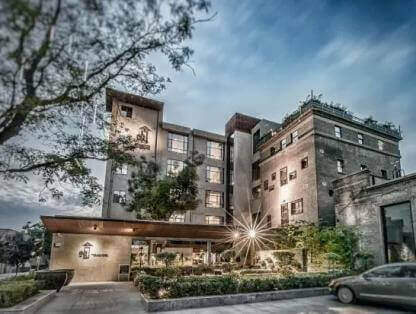 The Time Tunnel Designer Hotel in Xi'an is a 4-star hotel that is located just a short walk away from the Banpo Museum. The hotel is housed inside a former industrial building complex at the Banpo International Art Zone. There are several galleries, sculpture & pottery studios and ateliers in the immediate vicinity of the Time Tunnel Designer Hotel. Xi'an's city center is about 12km away and reaching the Xi'an Xianyang International Airport will usually take about 40 minutes. Airport transfer can be requested when making the room reservation and booked for an additional fee. The best way to reach the city center is by metro from the nearby Banpo Station which is only a 5-minute stroll away from the hotel.
The Time Tunnel Designer Hotel in Xi'an is a 4-star hotel that is located just a short walk away from the Banpo Museum. The hotel is housed inside a former industrial building complex at the Banpo International Art Zone. There are several galleries, sculpture & pottery studios and ateliers in the immediate vicinity of the Time Tunnel Designer Hotel. Xi'an's city center is about 12km away and reaching the Xi'an Xianyang International Airport will usually take about 40 minutes. Airport transfer can be requested when making the room reservation and booked for an additional fee. The best way to reach the city center is by metro from the nearby Banpo Station which is only a 5-minute stroll away from the hotel.
All rooms of the Time Tunnel Designer Hotel in Xi'an are air-conditioned (heating is available as well) and equipped with a refrigerator, minibar and international satellite TV. The hotel also has family rooms and suites and both smoking and non-smoking rooms can be requested. Free Wi-Fi is available in all rooms. Free Chinese-style breakfast is included when staying at this hotel and free bottled water and complimentary tea are provided in the rooms. Laundry service and luggage storage are available. The hotel provides 24-hour room service, daily housekeeping and private check-in/check-out. Trips to the world-famous Terracotta Warriors can be arranged (for a fee). The hotel includes a restaurant within its premises. As far as entertainment and relaxation is concerned, guests have the option to play billiards and darts, sing karaoke at special KTV game rooms or chill out in the hotel's garden.
0.5 miles away
Check availability & prices!
